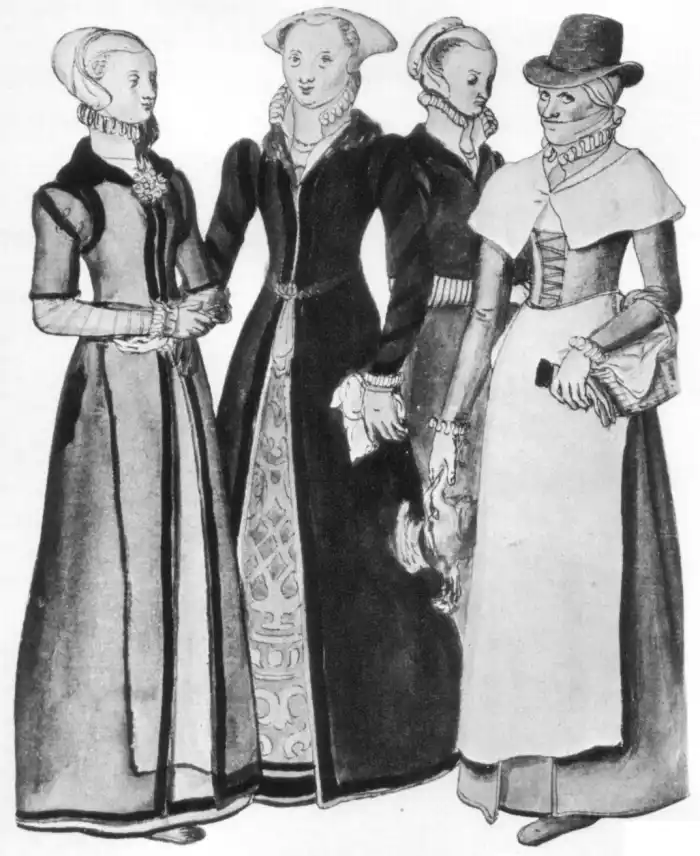Anglicans can be rather fussy about clergy hats, bishops love their mitres and priests their hats and caps. But we also have a long tradition in support of female head coverings. Below I will continue to collect Anglican resources that speak to the compelling case for veiling (female head coverings) in the Anglican Tradition. Feel free to comment additional resources, with citations, for inclusion and credit. While not every writer explicitly includes their support, I have not yet found an Anglican divine against the practice.
England just before the Reformation
In England under Henry VII (1485-1509), women wore, as Francois Boucher notes in A History of Costume in the West (1997): “low head-dresses, low-waisted gowns, and square necklines and long, tight sleeves” (242). Elizabeth of York, wife of Henry VII, is pictured here:
After the Reformation
The Elizabethan fashion of Protestant England dictated that the head was adorned with a hat, veil, coif or caul. This fashion therefore ensured that much of the hair was hidden by some form of head covering or hat. Laws attempted to restrict the “sumptuousness” of dress in order to curb extravagance, protect fortunes, and make clear the necessary and appropriate distinctions between levels of society. The regulation of “head coverings” in such an extensive manner speaks to the normative nature that St. Paul’s head covering over reformed English culture.
“None shall wear: Cowls, sleeves, partlets, and linings, trimmed with spangles or pearls of gold, silver, or pearl; cowls of gold or silver, or of silk mixed with gold or silver: except the degrees and persons above mentioned; and trimmed with pearl, none under the degree of baroness or like degrees.”
Enforcing Statutes of Apparel, issued at Greenwich, 15 June 1574, 16 Elizabeth I
Anglican Authorities in Support
“The Woman that is to be Churched, is to have a veil ; and good reason ; For if as S. Paul 1 Cor. 11. says, Every woman, when she prays in public, ought to have a veil or covering on her head, in token of her modesty and subjection : then much more, when she is to sit in a more eminent place of the Church, near to the holy Table, apart from the rest of her Sex, in the public view, ought she to have such a Veil or covering. Nor can it be deemed unreasonable for her at that time to have a Veil or habit distinct from others ; that so it may be known, for whom thanks is then particularly given.”
Bishop Anthony Sparrow, Bishop of Exon (1655)
“Paul is sometimes charged with apparent inconsistency in prescribing in one place the dress (a veil) which women must wear when they pray or prophesy in the congregation (I Cor. xi. 5), while elsewhere, and in the same Epistle, he forbids them to speak or preach in public (I Cor. xiv. 34, 35, comp. I Tim. ii. 11, 12)…
Or (2) it may have been, as some suppose, that I Cor. xiv represents the Apostle’s general rule, while in I Cor. xi he is dealing with an additional abuse, of women not only speaking in the congregation, but doing so while unveiled, which would be considered by all at that time as unbecoming.”
Bishop Authur Hall, Bishop of Vermont (1921)
“We know from the mention of them by Tertullian that in the year 200, the kiss, and the joining of hands, the crown, and the veil were used, while for the sacrifices and the sacrificial meal the Oblation (as he calls it) had of course been substituted, and with it the mystical meal of the Communion.”
“‘The words, “decently apparelled,” in the first rubric, were also added in 1661, but they only carry on the old usage; for they were inserted to ensure the woman wearing the customary white veil, which the Puritans had tried to give up, and which had been enforced by law (although there was then no rubric) in the reigns of James I and Charles I. The disregard of this rule has in modern times dimmed the beauty of the service, which needs the emphasis of a simple ceremonial, such as the white veil, the carrying of a light by the woman, and her being supported by two matrons — customs which seem to have been all continued after the Reformation.”
Percy Dearmer, Ch 16: Occasional Services
“Let the women array themselves in comely apparel, with modesty and discreet behavior, not with embroidered hair or gold or Pearls or costly array, but with an appearance that befits women who profess Godliness through good works.”
Anthony Scoloker, Instructions for a New Christian (1549)
“[with her head uncovered] i.e. without the peplum or shawl, which (see Art. in Smith’s Dictionary of Antiquities, and Dean Stanley’s note), used ordinarily as a covering for the body, was on public occasions thrown over the head also. In Oriental countries, however, the women wore, and still wear, a veil.”
Cambridge Bible for Schools and Colleges, Cambridge University Press (1882)
“For women, what does that head-covering look like? Scripture never gets that specific, but we can be assured from the witness of the Church going all the way back to the apostolic age, we’re not talking Islamic burkas or anything like that. From what we see in illustrations of Christian worship throughout the centuries, the most common headcovering was as simple as a scarf. The form or style of the covering itself isn’t important – and has always been culturally determined. What is important is that a woman’s head be covered during our worship and a man’s head be uncovered, both as signs of submission to God’s design for our roles.”
Headship and Its Symbols, The Rev’d William Klock, Reformed Episcopal Church, Anglican Church in North America (2009)

Leave a ReplyCancel reply